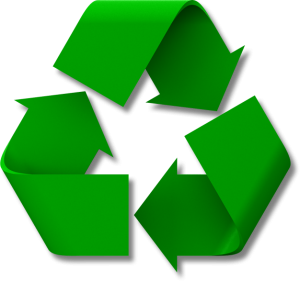Welcome Teachers!
The typical life of a manufactured item involves harvesting raw materials, manufacturing and selling products to consumers, and then disposing of the products into landfills. While this linear process is part of our daily life, it is not sustainable for our planet because the resources our planet can provide are finite. When an item has reached the end of this linear process, there is not a pathway for it to follow to be used again.
Fortunately, we have created the concept of recycling. Recycling turns this linear system of manufacturing goods into a closed system. However, this system is not perfect. Some materials, like aluminum and glass, can be recycled over and over and still maintain their initial properties. Other materials, like paper and plastics, can be recycled a limited number of times before they can no longer be used to create new products.
“Reduce, reuse, recycle” is a phrase we have been hearing for decades. Reducing and reusing are as important, if not more so, than recycling. The underlying goal for all of these steps is the same: to produce less waste and consume fewer resources. Reducing, reusing, and recycling provide economic benefits for consumers and manufacturers and environmental benefits for all.
The focus of this module is to alter the waste disposal behaviors at your school. Throughout this module you and your students will learn the importance of recycling and will conduct a waste audit and analysis to determine how to improve waste disposal at school. After completing this module students will be able to alter or create a recycling program at your school. They will report their findings to school officials and develop strategies to increase recycling and reduce overall waste from their school.
Sincerely,
Sarah Lykens
Outreach Assistant
Coalition for the Upper South Platte
http://cusp.ws
Teacher’s Guide
Walking the Curriculum
The Recycling Module consists of a pre- and post-assessment, a PowerPoint presentation, instructions for a school-wide waste audit and analysis, and a service learning day. The activities and supporting documents provided will lead your class to an assessment of waste production in order to improve an existing recycling program or start one at your school.
The online pre-assessment can be accessed here. The access code is KYLNT9A. Please give your students the access code and assign them a “first” and “last” name with which to enter to take the test. Because the test results will be visible to CUSP, we suggest that you assign your students a unique number sequence for their “first” name and your school name and grade for their “last” name so that they remain anonymous to us yet identifiable to you. Example: First name – 123, Last name – Arapahoe 9th.
Once your class has completed the service learning module, they need to take the post-assessment here. The access code for it is HANAG, and they can use the same name as they used for the pre-assessment. CUSP will send you the results of the assessments.
Teacher’s Guide is a detailed, step-by-step guide to follow as you complete this module.
Objectives
By completing this module, students will be able to: (1) collect and analyze data, (2) compile data in a useful manner to educate the public, (3) understand the significance of recycling in relation to economics and the environment, (4) discuss school waste production.
Objectives and Colorado State Standards
Time
The entire curriculum will take approximately 10 hours of class time to complete, plus a day of volunteering.
Pre-Assessment: 20 minutes
PowerPoint Presentation: 30-45 minutes
Vendor Information (optional): 20 minutes
School Waste Audit: 4 hours
Site-Analysis: 1 hour (as homework)
School-wide Analysis: 1 hour
Cost Analysis: 1 hour
Improvements Discussion: 45 minutes
Outreach: 90 minutes including presentations, unfinished work can be completed as homework.
Post-Assessment: 20 minutes
Estimated Time Required in .pdf format.
Supplies
All documents and worksheets are available on this module page.
Supplies is a detailed .pdf of materials needed for each activity.
ACTIVITIES
Vendor Information
Audit and Analysis
Cost Analysis
Improvements Discussion
Outreach
DOCUMENTS and MATERIALS
Vocabulary
Vendor Questions Worksheet
Individual Site Audit Form
Site Analysis
Site Analysis Form
School-wide Analysis Sheet
School-wide Analysis Form
Cost Analysis Worksheet
Improvements Worksheet
REFERENCES
“Common Wastes & Materials.” Wastes – Resource Conservation – Common Wastes & Materials. Environmental Protection Agency, 13 June 2012. http://www.epa.gov/osw/conserve/materials/index.htm.
Joffe-Walt, Chana. “Planet Money.” Recycling Industry Slows As Consumers Shop Less. KPLU. NPR, 22 Dec. 2008. http://www.npr.org/templates/story/story.php?storyId=98603697.
“Life-Cycle of Waste Image and Description.” Climate Change & Waste. Environmental Protection Agency, 4 June 2012. http://www.epa.gov/climatechange/wycd/waste/lifecycle.html.
Medina, Martin. “Global Recycling Supply Chains and Waste Picking in Developing Countries.” UNU-WIDER, 2009. http://www.wider.unu.edu/publications/newsletter/articles/en_GB/12-2009-wider-angle-1/.
Plastics. http://plastics.americanchemistry.com/.
“Recycling at School.” MassRecycle. http://www.massrecycle.org/recyclingatschool.html.
“Recycling Market Development.” Wastes – Resource Conservation – Reduce, Reuse, Recycle. Environmental Protection Agency, 13 June 2012. http://www.epa.gov/epawaste/conserve/rrr/rmd/index.htm.
“Recycling Means Business.” Environmental Protection Agency, September 1995. http://www.epa.gov/epawaste/conserve/rrr/pubs/rmb.pdf.
“Recycling of Materials Local or global?” Pieter van Beukering, Institute for Environmental Studies – Amsterdam T. Randall Curlee, Oak Ridge National Laboratory Tennessee http://www.elaw.org/system/files/Recycling.of.Materials.Local.or.Global.1998.pdf.
“Recycling.” Wastes – Resource Conservation – Reduce, Reuse, Recycle. Environmental Protection Agency, 13 June 2012. http://www.epa.gov/osw/conserve/rrr/recycle.htm.
Walls-Thumma, Dawn. “Recycling Instead of Landfills.” Green Living. National Geographic. http://greenliving.nationalgeographic.com/recycling-instead-landfills-2216.html.
What Do All Those Plastic Resin Codes Mean? Colorado Recycles. http://www.colorado-recycles.org/pdf/recyclingtips/newresincodes.pdf.
“What Happens When You Recycle?” Grays Harbor County. http://www.co.grays-harbor.wa.us/info/pub_svcs/recycle/whenyourecycle.htm.
Wieman, Bethany. “Recycling Vs. Landfills or Incinerators.” Green Living. National Geographic. http://greenliving.nationalgeographic.com/recycling-vs-landfills-incinerators-3266.html.
Wills, Amanda. “The Ultimate Plastic Breakdown.” Earth911, 23 Nov. 2009. http://earth911.com/news/2009/11/23/the-ultimate-plastic-breakdown/.
ADDITIONAL RESOURCES
Park County Vision 2020 Recycling Center: http://www.parkcountyvision2020.org/environment
U. S. Environmental Protection Agency. Recycling is Working. http://www.epa.gov/epawaste/conserve/rrr/pubs/rmb.pdf
U. S. Environmental Protection Agency. Recycling. http://www.epa.gov/osw/conserve/rrr/recycle.htm
More information on starting recycling programs and waste audits: http://www.recyclemoreminnesota.org/how/school.html
http://syracusecoe.org/coe/images/allmedia/classroom/SMMToolkit6.pdf
http://www.cafr.org/resources/schools.php
http://www.greenschools.net/article.php?id=99
Green School article: http://www.edutopia.org/green-building-students-curriculum
Information on Recycling initiative in New York City: http://www.grownyc.org/recyclingchampions
Great Pacific Ocean Garbage Patch: http://www.mnn.com/earth-matters/translating-uncle-sam/stories/what-is-the-great-pacific-ocean-garbage-patch